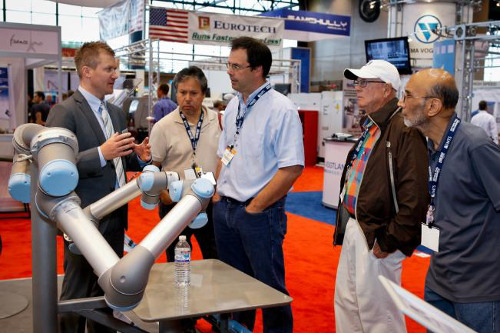 |
| August 26, 2014 | Volume 10 Issue 32 |
Designfax weekly eMagazine
Archives
Partners
Manufacturing Center
Product Spotlight
Modern Applications News
Metalworking Ideas For
Today's Job Shops
Tooling and Production
Strategies for large
metalworking plants
Mike Likes:
World's first robot with advanced safety settings
With eight new adjustable safety-rated functions, Universal Robots now provides the only robot in the world that adapts advanced safety settings to each specific application.
The third generation of the company's UR5 and UR10 robot arms also comes equipped with True Absolute Encoders that eliminate the need for re-initializing the robot, enabling automatic startup and easier integration into other machinery.
Visitors to Universal Robots' booth (E-4841) at IMTS will be able to program a robot with safety features that adjust to the context it operates within. Esben Ostergaard, the CTO of Universal Robots, explains that the patented new safety concept is a logical development of the Danish robot manufacturer's collaborative robot arms.

"When a human enters the robot's work-cell, the robot arm can operate in reduced mode, and then resume full speed when he leaves again. Or, the robot can run full speed inside a CNC machine, for example, and then reduced speed when outside," says Ostergaard.
To achieve a switch between normal and reduced safety mode, eight safety functions are monitored by the new patented safety system: joint positions and speeds, TCP positions, orientation, speed and force, as well as the momentum and power of the robot. The settings can only be changed in a password-protected area.
This robot knows its position upon power-up
Another key innovation of Universal Robots' new generation of collaborative robots is the True Absolute Encoders, allowing the robot to achieve faster startup because its position is recognized upon power-up.
"With the integration of the True Absolute Encoder, our robot-arms can be integrated even more easily into other machines, while startup also becomes much faster and simpler for all applications," says Ostergaard.
Unlike most other industrial robots with incremental encoders that work like absolute encoders (until the battery runs out), the encoders in the UR robots are not battery driven. That is why they are called "True Absolute Encoders," eliminating the need to frequently re-initialize the robot arms since their position in space is known despite the robot not requiring battery power to achieve this function.
Improvements based on user feedback
Though the robot arms UR5 and UR10 are now equipped with numerous new features, Universal Robots remains true to its approach of user-friendly, lightweight robots. The visual appearance of the six-jointed UR5 and UR10 robot arms, with payloads of 5 kg and 10 kg respectively, remains unchanged.
But inside the robot arm itself, as well as in the controller, are hidden surprises: 16 additional digital I/Os double the number of built-in I/Os, which are easy to configure either as digital signals or as safety signals. The control box has a revised design and a rebuilt controller to further improve the possibilities for connecting equipment to the control boxes.
Source: Universal Robots
Published August 2014
Rate this article
View our terms of use and privacy policy
